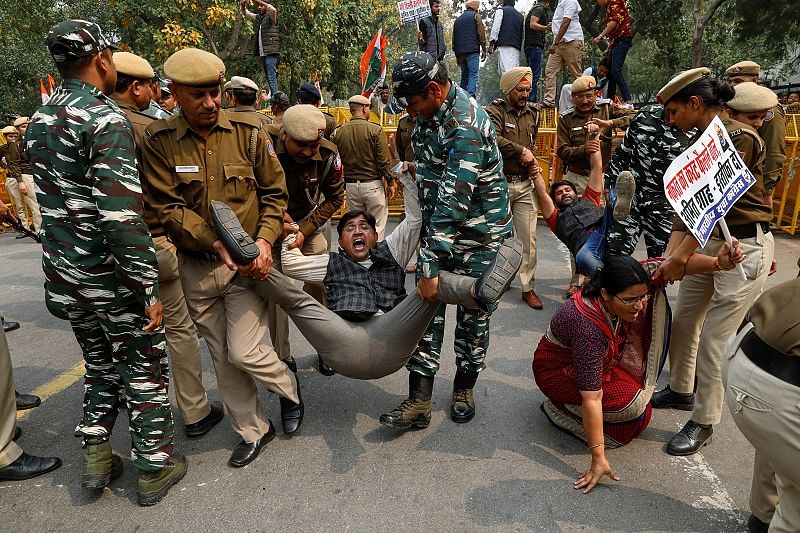
One dislikes passing judgement on others, mindful of the Biblical saying “judge not lest ye be judged.” And yet, a time comes when it is difficult to be dispassionate, particularly when there is organised violence aimed at creating fear and poisoning relations between India’s two largest religious communities. What makes the recent horror in north-east Delhi totally unforgivable, especially for those of us who have served in one of the two All-India Services (IAS/IPS), is the complete abdication of its statutory duties by Delhi Police.
The events of the last week of February 2020 were the tragic denouement of a sequence of happenings over the past two months, as Delhi Police slipped deeper and deeper into the mire of partisanship and extremely unprofessional functioning, when one was left wondering if the Indian Penal Code (IPC) and the Criminal Procedure Code (CrPC) were applicable in the National Capital Region of Delhi. There were four instances when Delhi Police gave short shrift to the laws of the land and, indeed, to the very Constitution they are sworn to uphold.
In the case of the Jamia incident of December 15, 2019, the videos of the library assault point to a mentality in the guardians of law and order of “teaching a lesson” to students. India’s criminal laws do not permit the police to use force to an extent greater than is needed to restore normalcy. Helmeted police assaulting with lathis students in the library could hardly be termed as mob control. By this one action, Delhi Police set off a chain reaction that has since reverberated across university campuses throughout the country.
Even more inexcusable was the police apathy when armed thugs invaded the JNU campus on the evening of January 5, 2020. The police decided to stay put at the JNU gate even when there was enough evidence that cognizable offences involving danger to life and property were being committed on the campus. What is worse, two months after the incident, no FIRs have been registered against those who indulged in violence and vandalism; instead, FIRs have been lodged against the victims of the assault.
Three violations of the Election Commission’s Model Code of Conduct, two by elected Members of Parliament (one of them a minister in the Government of India) and one by a BJP candidate, during the Delhi Assembly elections, merited action under the IPC. Delhi Police did not invoke Sections 153A/295A of the IPC, which would have served as a salutary reminder to politicians not to resort to incendiary campaigning to win votes.
The final nail in the coffin was hammered in when the BJP’s Kapil Mishra decided to refurbish his eroded electoral standing by threatening direct action if the anti-CAA/NRC protesters in north-east Delhi did not remove their blockage of public spaces. The resultant outbreak of violence spiraled into full-fledged arson and murder. It strains credulity that with protests across the city since December 2019, followed by elections in January 2020, the police were not alert enough to take preventive action against criminal elements, check illegal firearms and seal Delhi’s borders with neighbouring states, especially UP, to prevent infiltration of outsiders. Over three days, the inaction (at best) and complicity (at worst) of the police was in full view, both nationally and internationally.
Three basic lessons in maintenance of law and order were ignored by Delhi Police:
Convey control: At no stage should politicians, their henchmen and anti-social elements get the feeling that they can operate in violation of the law. Strong preventive action under the CrPC and the local police laws, externment from Delhi of certain criminal elements and, where required, use of draconian laws like the National Security Act would have sent a clear message to those intent on disturbing the public peace.
Zero tolerance: Unless incidents of assault and arson are dealt with firmly and promptly, they tend to snowball into a free-for-all between members of different communities. Lathi charges are normally enough to cool down even impetuous hotheads; however, on occasion, stronger action, such as police firing, may be required to restore order in a short timeframe and reduce casualties.
Leading from the spot: By far, the most crucial element in law and order policing is the quality of leadership. The leader (the District Magistrate/Superintendent of Police/Police Commissioner) must inspire confidence in his/her force by being on the street. It was inexcusable that senior police officers, from the Delhi Police Commissioner down, were not visible till the third day of the disturbances. A leaderless police force took the path of least resistance since there was no one in authority to spur it to action.
Delhi Police has suffered serious damage to its image and self-esteem. A new Police Commissioner has taken charge. It is now time for Delhi Police to assert its authority and make it clear that it will not tolerate violations of the law from any quarter. It is also time for all governments, including the central government, which supervises Delhi Police, to act on the 2006 directions of the Supreme Court in the Prakash Singh case, aimed at professionalising the police and insulating them from political interference. Above all, it is time for my fellow colleagues in the two All-India Services charged with the maintenance of law and public order to reaffirm their complete faith in and loyalty to the Constitution of India and rise above all sectarian considerations in discharging their duties honestly and diligently.
(The writer, a retired IAS officer, has served as District Magistrate and Divisional Commissioner in Maharashtra)